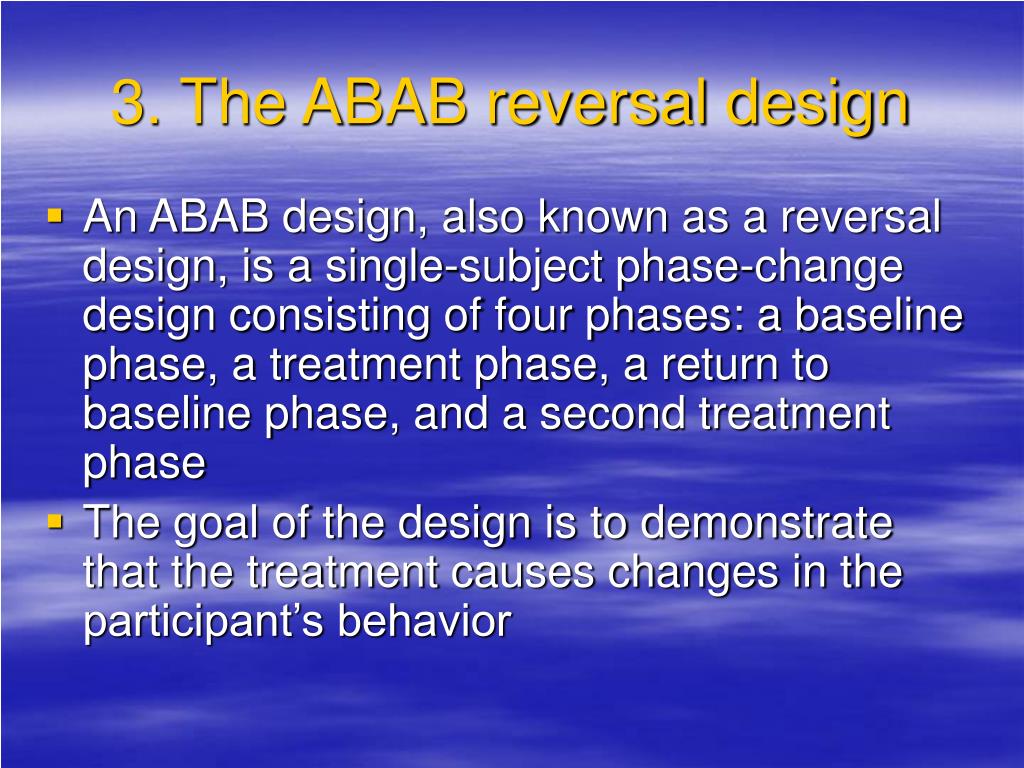Table Of Content

The mere presence of variability does not mean that a single-case approach should be abandoned, however. Indeed, identifying the sources of variability and/or assessing new measurement strategies can be evaluated using SCDs. Under these conditions, the outcome of interest is not an increase or a decrease in some behavior or symptom but a reduction in variability. Once accomplished, the researcher has not only learned something useful but is also better prepared to evaluate the effects of an intervention to increase or decrease some health behavior. In conclusion, both ABA and ABAB design are valuable research designs in the field of applied behavior analysis. ABA design is simpler and easier to apply, while ABAB design is more complex but allows researchers to test the effectiveness of a treatment over time.
Replication for Internal and External Validity
For data patterns with A phase trend, the randomized AB phase design also has sufficient power, provided that the treatment effect is in the same direction as the A phase trend. When the treatment effect is in the opposite direction from the A phase trend, the randomized AB phase design only has sufficient power when both the A phase trend and the B phase trend are small (Data Patterns 6, 7, and 9). It is also important to note that the RT only has sufficient power for large treatment effects. The β1 and β3 values were based on a survey by Solomon (2014), who calculated trend values through linear regression for a large number of single-case studies. A random-effects meta-analysis showed that the mean standardized trend regression weight for all analyzed data was .37, with a 95% confidence interval of [.28 ; .43]. On the basis of these results, we defined a “small” trend as a standardized regression weight of .25 and a “large” trend as a standardized regression weight of .50.
REVERSAL DESIGNS

Therefore, we performed a Monte Carlo simulation study to investigate the effect of unexpected linear data trends on the power of the RT when it is used to assess treatment effects in randomized AB phase designs. A secondary goal was to provide guidelines for the number of measurement occasions to include in a randomized AB phase design, in order to achieve sufficient power for different types of data patterns containing trends and various treatment effect sizes. Following the guidelines by Cohen (1988), we defined “sufficient power” as a power of 80% or more. Multiple-baseline and multiple-probe designs are appropriate for answering research questions regarding the effects of a single intervention or independent variable across three or more individuals, behaviors, stimuli, or settings.
Analyzing randomized AB phase designs with randomization tests: a hypothetical example
That is, the level of the dependent variable should be stable enough to predict its direction if the treatment was not introduced. If there is a trend in the direction of the anticipated treatment effect during baseline, or if there is too much variability, the ability to detect a treatment effect will be compromised. Thus, stability, or in some cases a trend in the direction opposite the predicted treatment effect, is desirable during baseline conditions. By alternating between these two phases, the ABAB design provides a clear and systematic way of examining the effects of the intervention on the target behavior. This design allows for the assessment of both the immediate effects of the intervention and the reversibility of those effects when the intervention is withdrawn during the second baseline phase.

For example, the threat known as “testing” refers to the fact that repeated measurement alone may change behavior. To address this, baseline phases need to be sufficiently long, and there must be enough within and/or between participant replications to rule out the effect of testing. Such logic applies to a number of other potential threats (e.g., instrumentation, history, regression to the mean, etc.). In addition, a plethora of new analytic techniques can supplement experimental techniques to make inferences about causal relations.
Opening October 24, Ars Nova's Hound Dog Takes Audiences to Elvis Presley's Graceland - Playbill
Opening October 24, Ars Nova's Hound Dog Takes Audiences to Elvis Presley's Graceland.
Posted: Mon, 24 Oct 2022 04:44:56 GMT [source]
Does Processed Food Truly Contribute to Autism?
Yes, ABAB design can be used even when the behavior being studied is rare or difficult to observe. However, it may require more time and resources to carry out, as researchers need to establish a stable baseline before introducing the treatment. When considering autism treatment options, it's important to choose the approach that best suits the needs of the individual with autism. To make an informed decision, it's crucial to consider several factors and collaborate with professionals. ABA therapy is typically implemented by trained professionals, such as behavior analysts or therapists.
This latency brings into question the assumption that the manipulation of the independent variable is responsible for the observed changes in the dependent variable. It is possible that the observed change may be more appropriately attributed to some factor outside the control of the experimenter. To rule out the plausibility of an extraneous variable, the experimental effect must be replicated, thereby showing that although there may be a delay, changes in the dependent variable reliably occur following changes to the independent variable. This type of replication (within study) is a primary characteristic of SSEDs and is the primary basis for internally valid inferences. In the top panel of Figure 10.5, there are fairly obvious changes in the level and trend of the dependent variable from condition to condition.
This design involves multiple phases of intervention (B) alternated with baseline phases (A), providing a more robust evaluation of treatment effects. One commonly used alternative to the ATD is called the adapted alternating treatments design (AATD; Sindelar, Rosenburg, & Wilson, 1985). Whereas the traditional ATD assesses the effects of different interventions or independent variables on a single outcome variable, in the AATD, a different set of responses is assigned to each intervention or independent variable. The resulting design is similar to a multiple-baseline, across-behaviors design with concurrent training for all behaviors.
(PDF) Statistical analysis for single case data: Draft chapter - ResearchGate
(PDF) Statistical analysis for single case data: Draft chapter.
Posted: Sun, 24 Jan 2016 01:02:07 GMT [source]
For example, a parent or a teacher may simply refuse to stop implementing a treatment once they observe desirable changes in a child’s behavior. Behaviors that produce irreversible changes are also unconducive to designs involving withdrawal. Perhaps the simplest example would be a multiple baseline across individuals with similar problems. Each individual would experience an AB sequence, where the durations of the baseline phases vary. Another possibility is to target different behavior in the same individual in a multiple-baseline across behavior design. For example, a skills training program to improve social behavior could target different aspects of such behavior in a sequential fashion, starting with eye contact, then posture, then speech volume, and so on.
Whether it's implementing individualized interventions through ABA or conducting research studies using ABAB Design, both approaches contribute to the advancement of our understanding of behavior and the development of effective interventions. The ABAB design offers a powerful method for understanding the impact of interventions on behavior. Its systematic approach allows researchers to make informed decisions about the effectiveness of various interventions and tailor treatment plans accordingly. ABA is widely applied in various settings, including schools, clinics, homes, and community-based programs.
In contrast, the reversal design requires the active reversal of the intervention conditions. By contrast, Panel B of Figure 2 shows a data set in which an increasing trend is present during the baseline phase. As a result, any increases observed during the intervention phase may simply be a continuation of that trend rather than the result of the manipulation of the independent variable. This underscores the importance of “good” baseline data, and, in particular, of the need to continue collecting baseline data to eliminate the possibility that any trends observed are likely to continue in the absence of an intervention. In the current climate of evidence-based practice, the tools provided by SSEDs are relevant for researchers and practitioners alike.
Throughout the ABA design process, various research techniques and methodologies are employed, such as defining the independent variable, measuring the dependent variable, establishing a control group, and implementing appropriate experimental designs. Statistical analysis plays a crucial role in interpreting the data and determining the significance of the results. In this phase, the treatment is withdrawn or removed to observe if the behavior reverts back to its baseline level.
Overall, the four issues discussed above—effect detection, magnitude of effect, quality of the inference, and practice decisions—reflect the critical dimensions involved in the analysis of SSED. The importance of any one dimension over the other will likely depend on the purpose of the study and the state of the scientific knowledge about the problem being addressed. As a result, this study provides strong evidence that the question-asking intervention results in increases in collateral question-asking. Numerous criteria have been developed to identify best educational and clinical practices that are supported by research in psychology, education, speech-language science, and related rehabilitation disciplines.
The main effect of number of measurement occasions showed that the power of randomized AB phase designs with 60 measurement occasions hardly benefits from an increase to 90 or even 120 measurement occasions. Statistical inference refers to assessing the statistical significance of treatment effects through hypothesis testing or by constructing confidence intervals for the parameter estimates (Heyvaert et al., 2015; Michiels, Heyvaert, Meulders, & Onghena, 2017). On the one hand, inferential procedures can be divided into parametric and nonparametric procedures, and on the other hand, they can be divided into frequentist and Bayesian procedures. One possibility for analyzing randomized AB phase designs is to use parametric frequentist procedures, such as statistical tests and confidence intervals based on t and F distributions.
For example, Raiff and Dallery [72] achieved a direct replication of the effects of internet-based contingency management (CM) on adherence to glucose testing in four adolescents. One goal of the study was to establish experimental control by the intervention and to minimize as many extraneous factors as possible. It cannot answer questions about generality across settings, behavior change agents, target behaviors, or participants that differ in some way from the original experiment (e.g., to adults diagnosed with type 1 diabetes).
Kratochwill et al. argue that the internal validity threats of history and maturation are mitigated when SCEDs contain at least two AB phase pair repetitions. For these reasons, they argue that only phase designs with at least two AB phase pair repetitions (e.g., an ABAB design) are valid SCEDs, and that designs with only one AB phase pair repetition (e.g., an AB phase design) are inadequate for drawing valid inferences. Similarly, Tate et al. and Vohra et al. do not consider the AB phase design as a valid SCED.

No comments:
Post a Comment